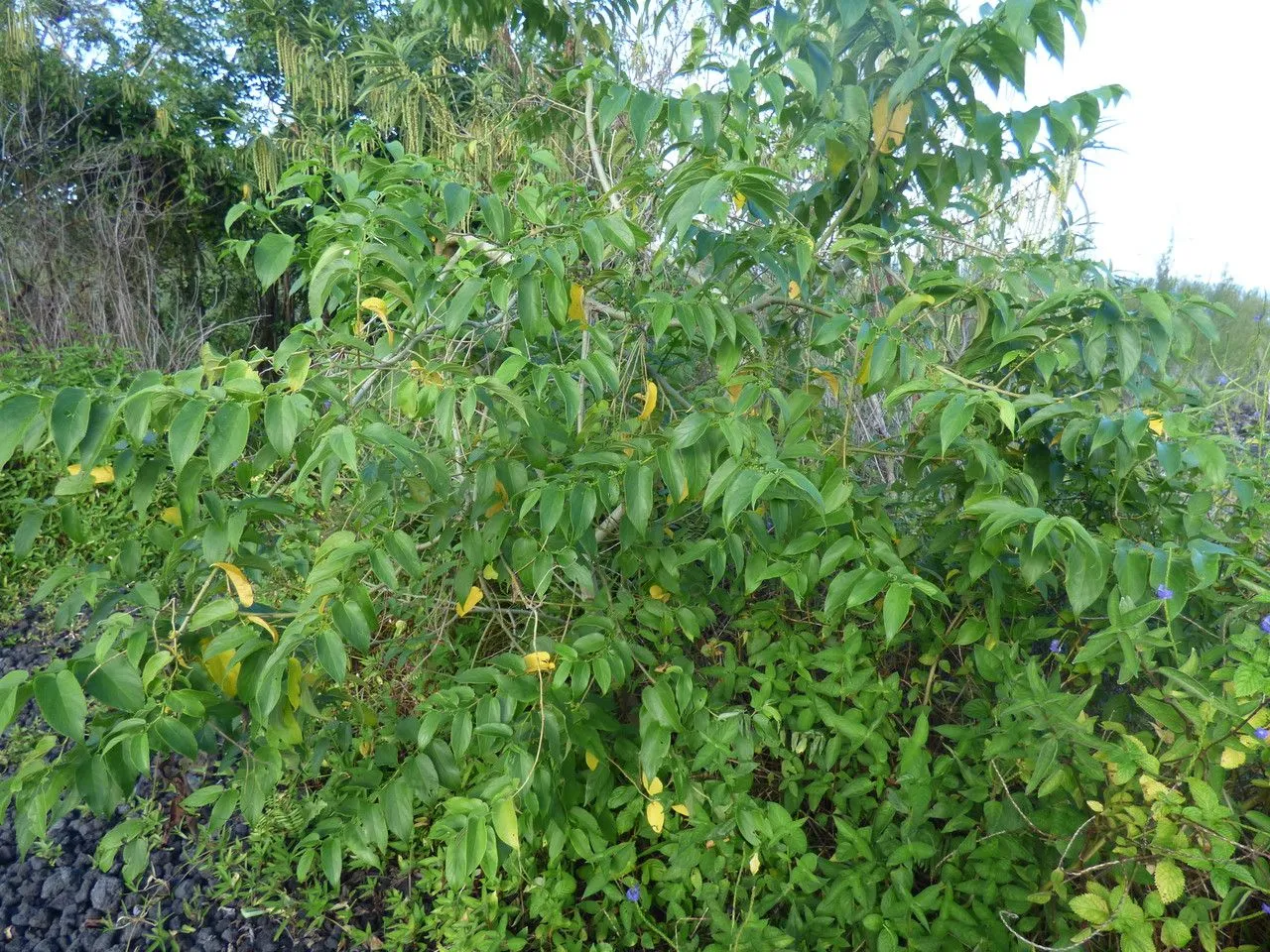
Author: Blume
Bibliography: Mus. Bot. 2:62. 1856
Year: 1856
Status: accepted
Rank: species
Genus: Trema
Vegetable: False
Observations: Unknown
Large Poison-Peach (Trema orientalis)
The Large Poison-Peach, scientifically known as Trema orientalis, belongs to the Cannabaceae family. This botanical species was first detailed in the mid-19th century by the botanist Blume, as referenced in Mus. Bot. 2:62 from the year 1856.
Despite its rather ominous common name, the Large Poison-Peach is an intriguing plant valued for various traditional uses across different cultures. The plant is adapted to a variety of habitats, which has made it widespread in tropical and subtropical regions. Its adaptability also contributes to its reputation as a pioneer species, often thriving in disturbed soils and playing a crucial role in ecological succession by stabilizing environments and providing habitat for other plant and animal species.
Morphologically, Trema orientalis can be recognized by its distinctive features. It typically grows as a small to medium-sized tree, exhibiting a fast growth rate that makes it a common sight in secondary forests. The leaves are simple, alternate, and have a serrated margin, often presenting a vibrant green hue. The plant produces small, inconspicuous flowers that lead to the formation of tiny fruits, which serve as a food source for local wildlife.
While comprehensive studies on the Large Poison-Peach remain limited, its significance in traditional medicine is noteworthy. In various regions, parts of the plant are harvested for their purported medicinal properties. It’s claimed that different extracts from the tree can be used to treat ailments ranging from skin issues to digestive problems, although these uses often rely on anecdotal evidence and long-standing folk practices rather than extensive scientific validation.
In terms of ecological importance, the Large Poison-Peach contributes significantly to the ecosystems it inhabits. Its ability to quickly establish itself allows it to reduce soil erosion and enhance soil fertility through leaf litter decomposition. Furthermore, its fruits provide nourishment to numerous bird species and other fauna, supporting local biodiversity.
Overall, Trema orientalis is a resilient and ecologically valuable plant that merits further scientific attention. Understanding its full potential, whether in traditional medicine or ecological restoration, could unlock new benefits for both human and environmental health.
Eng: indian charcoaltree, oriental trema, charcoaltree, large poison-peach, peach-cedar, poison-peach, rough trema, tree-peach, woolly-cedar
Msa: mengkirai
En: Large poison-peach, Peach-cedar, Poison-peach, Tree-peach, Rough trema, Woolly-cedar, Charcoaltree, Indian charcoaltree, Oriental trema, Indian Charcoal Tree, Indian Nettle, Oriental Nettle, Pigeon Wood, Poison Peach, Pigeonwood, Gunpowder-tree, Charcoal tree, Elm, Gunpowder tree
Zh: Yi se shan huang ma
Fr: Bois d’Andrèze, Andrèze
Ms: Mengkirai
Taken Oct 13, 2017 by Hugo SANTACREU (cc-by-sa)
Taken Feb 7, 2022 by Noemia Viana (cc-by-sa)
Taken Jan 3, 2022 by Subrata kumar Behera (cc-by-sa)
Taken Jan 14, 2020 by Anziz AHMED ABDOU (cc-by-sa)
Taken Jan 4, 2022 by Hery DAUNES (cc-by-sa)
Taken Jan 19, 2020 by Pereira Carolina (cc-by-sa)
Taken Apr 22, 2021 by Yann Lalk (cc-by-sa)
Taken Apr 2, 2017 by Hugo SANTACREU (cc-by-sa)
Taken Jul 24, 2019 by Pierre-Marie GINDRE (cc-by-sa)
Taken Oct 18, 2022 by Blue Bottle (cc-by-sa)
Taken Nov 24, 2022 by IMMORTAL_2209 (cc-by-sa)
Taken Apr 2, 2017 by Hugo SANTACREU (cc-by-sa)
Taken Apr 2, 2017 by Hugo SANTACREU (cc-by-sa)
Taken Apr 2, 2017 by Hugo SANTACREU (cc-by-sa)
Taken Oct 13, 2017 by Hugo SANTACREU (cc-by-sa)
Taken Jan 1, 1900 by EOL − Forest & Kim Starr (cc-by)
Taken Jan 1, 1900 by EOL − Marco Schmidt (cc-by-nc-sa)
Taken Jan 1, 1900 by EOL − Forest & Kim Starr (cc-by)
Taken Jan 1, 1900 by EOL − Forest & Kim Starr (cc-by)
Taken Apr 2, 2017 by Hugo SANTACREU (cc-by-sa)
Taken Oct 26, 2022 by Sudhanshu Kumar (cc-by-sa)
Taken May 24, 2022 by Marc Roussin (cc-by-sa)
Taken Jun 18, 2019 by Chris Clark (cc-by-sa)
Taken Sep 29, 2019 by Santiago Maurício (cc-by-sa)
Taken Mar 25, 2016 by Hugo SANTACREU (cc-by-sa)
Growth habit: Tree
Family: Myrtaceae Author: (F.Muell.) K.D.Hill & L.A.S.Johnson Bibliography: Telopea 6: 402 (1995) Year: 1995 Status:…
Family: Rubiaceae Author: Pierre ex A.Froehner Bibliography: Notizbl. Bot. Gart. Berlin-Dahlem 1: 237 (1897) Year:…
Family: Sapindaceae Author: Koidz. Bibliography: J. Coll. Sci. Imp. Univ. Tokyo 32(1): 38 (1911) Year:…
Family: Asteraceae Author: A.Gray Bibliography: Pacif. Railr. Rep.: 107 (1857) Year: 1857 Status: accepted Rank:…
Family: Fabaceae Author: Medik. Bibliography: Vorles. Churpfälz. Phys.-Ökon. Ges. 2: 398 (1787) Year: 1787 Status:…
Family: Aspleniaceae Author: (Cav.) Alston Bibliography: Bull. Misc. Inform. Kew 1932: 309 (1932) Year: 1932…